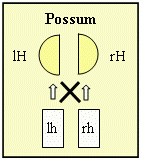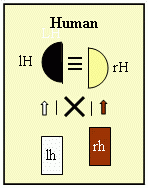|
Evolutionary
Theories of Asymmetrization of Organisms, Brain and Body
(III):
The relationship between brain
hemispheres and sides of the body
Why nerves are crossed?
Why corpus callosum and ipsilateral nerve connections were
developed?
 Lateral
asymmetry in Phylogeny appears in placental mammals (Karamian,
1970). If we compare structures of possum (bilaterally
symmetric) and human (triaxially asymmetric) can help us
understand role and mechanisms of lateralization.
Bilaterally symmetric possum has simple contra lateral nerve
connections between hemispheres and sides of the body (Fig).
The reason for the cross over is unclear (Walker, 1980).
Contrary to the nerves, energy connections (blood vessels)
aren’t crossed (ipsilateral schema). Lateral
asymmetry in Phylogeny appears in placental mammals (Karamian,
1970). If we compare structures of possum (bilaterally
symmetric) and human (triaxially asymmetric) can help us
understand role and mechanisms of lateralization.
Bilaterally symmetric possum has simple contra lateral nerve
connections between hemispheres and sides of the body (Fig).
The reason for the cross over is unclear (Walker, 1980).
Contrary to the nerves, energy connections (blood vessels)
aren’t crossed (ipsilateral schema).
 Legend:
l, r - left, right; H - hemispheres of the brain; h - hands; Legend:
l, r - left, right; H - hemispheres of the brain; h - hands;
x – contra lateral nerve connections; -
carotid arteries.
Morphological and related functional features in human
Phylogeny during lateral asymmetrization
 Morphological
features.
1. Corpus callosum — the largest white matter structure in
the brain, consisting of 200-250 million contra lateral
axonal projections connecting different regions of brain
hemispheres. The corpus callosum has been reported to be
larger in males (Bishop,
1997) and slightly larger in left-handed people than
right-handed people (Witelson, 1985;
Driesen, 1995). 2. Ipsilateral connections—direct
nerve pathways connecting each hemisphere with the same side
of the body (Fig). Morphological
features.
1. Corpus callosum — the largest white matter structure in
the brain, consisting of 200-250 million contra lateral
axonal projections connecting different regions of brain
hemispheres. The corpus callosum has been reported to be
larger in males (Bishop,
1997) and slightly larger in left-handed people than
right-handed people (Witelson, 1985;
Driesen, 1995). 2. Ipsilateral connections—direct
nerve pathways connecting each hemisphere with the same side
of the body (Fig).
Functional features.
1. Asymmetry and hemisphere specialization manifested in
dominance of one hemisphere over the other on different
phases of functions’ evolution. 2. Asymmetry of hands and
other organs.
 Legend:
l, r - left, right; H - hemispheres of the brain; h - hands; Legend:
l, r - left, right; H - hemispheres of the brain; h - hands;
x – contra lateral nerve connections;
- carotid arteries;
≡ - corpus callosum;
| | - ipsilateral
nerve connections.
All abovementioned evolutionary innovations are closely
related to lateralization, however their purpose is unclear.
Moreover some scientists think that intra hemisphere
connections can only level their changes, therefore
different hemispheres should require less connections than
similar (Pribram, 1975).
Evolutionary role of corpus callosum, contra and ipsilateral
nerve connections
Contra lateral nerve connections.
One can assume that increasing brain blood flow can improve
regulation. , then contra lateral nerve connections form
negative feedback thus providing symmetry of hands and other
organs. So, evolutionary role of contra connections is to
preserve lateral symmetry of bilaterally symmetric or
certain level of asymmetry of triaxially asymmetric
organisms.
Corpus callosum
creates sequential connection between hemispheres and their
asymmetry.
Evolutionary role of ipsilateral connections is to
create positive relations that change the equilibrium state.
They provide adaptation to new conditions.
The picture closely resembles that of the refrigerator:
negative feedback preserves the required temperature, while
positive connection—changes it.
◄ The
evolution of Asymmetry (I) ◄
Brain
Asymmetry (II)
Asymmetry of paired organs, hands (IV) ►
Questions
Predictions
|